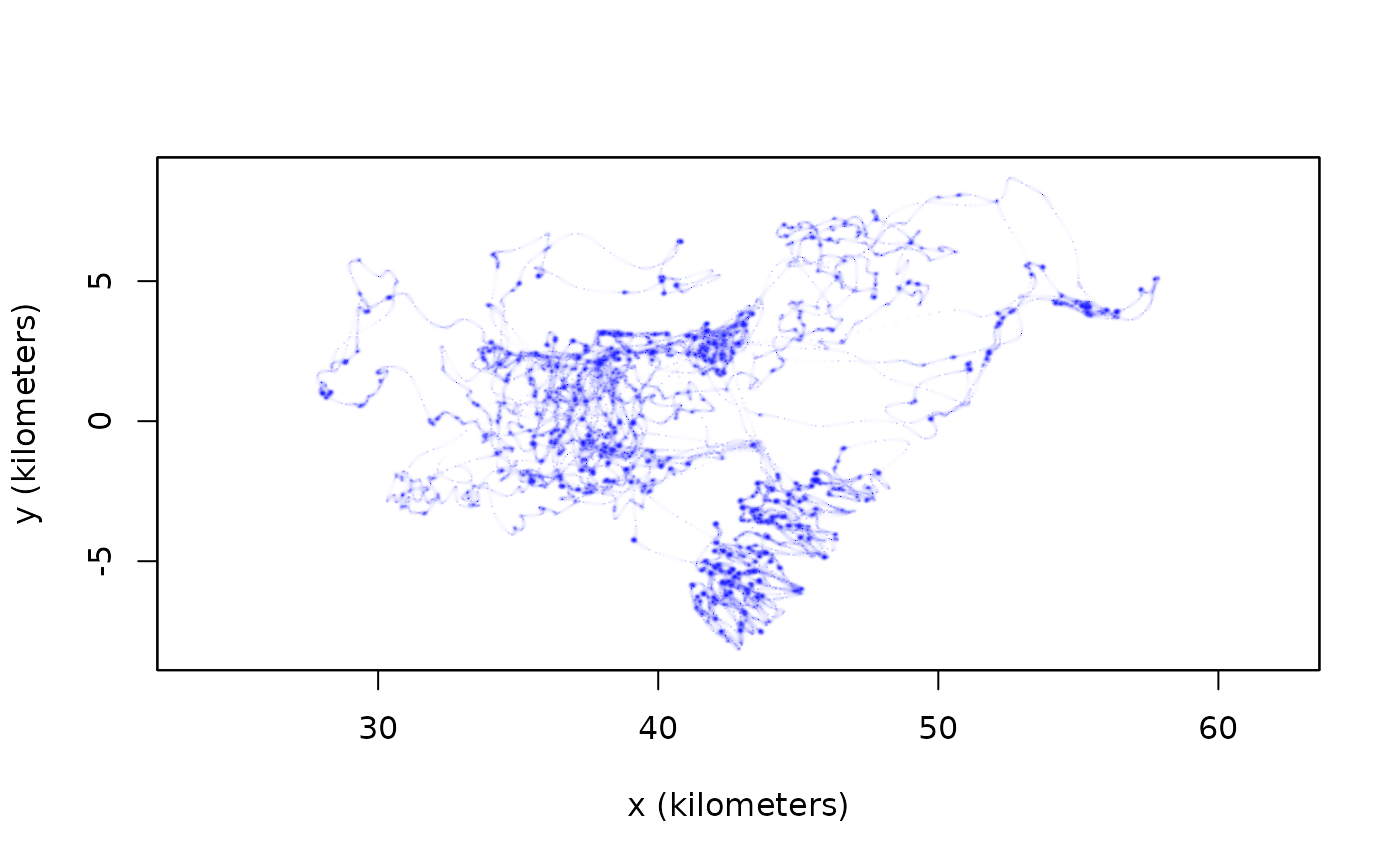Calculate a Kriged occurrence distribution estimate
occurrence.RdThis function calculates an occurrence distribution from telemetry data and a continuous-time movement model.
occurrence(data,CTMM,R=list(),SP=NULL,SP.in=TRUE,H=0,variable="utilization",res.time=10,
res.space=10,grid=NULL,cor.min=0.05,dt.max=NULL,buffer=TRUE,...)Arguments
- data
A
telemetryobject or list oftelemetryobjects.- CTMM
A
ctmmmovement model, as from the output ofctmm.select, or a list ofctmmobjects.- R
A named list of raster covariates if
CTMMcontains an RSF model.- SP
SpatialPolygonsDataFrame object for enforcing hard boundaries.
- SP.in
Locations are assumed to be inside the
SPpolygons ifSP.in=TRUEand outside ofSPifSP.in=FALSE.- H
Optional additional bandwidth matrix for future use.
- variable
Either
"utilization"or"revisitation". Only utilization is accurately estimated.- res.time
Number of temporal grid points per median timestep.
- res.space
Number of grid points along each axis, relative to the average diffusion (per median timestep) from a stationary point.
- grid
Optional grid specification via
raster,UD, or list of arguments (Seeakdefor details).- cor.min
Velocity correlation threshold for skipping gaps.
- dt.max
Maximum absolute gap size (in seconds) for Kriging interpolation. If left
NULL, the median ofdiff(data$t)will be used.- buffer
Buffer the observation period, according to the minimum gap specified by
cor.minanddt.max, to include more probable locations if possible.- ...
Not used.
Details
The arguments cor.min or dt.max are used to prevent the interpolation of large gaps, which would bias the estimate to more resemble the movement model than the data. Because cor.min can produce an empty range with fractal movement models, the larger of the two rules is employed for interpolation.
If buffer=TRUE, then the data are also extrapolated according to the minimum of the two rules (cor.min and dt.max) which is limited to cases where persistence of motion is modeled.
Value
Returns a UD object containing the sampled grid line locations x and y, the probability density and cumulative distribution functions evaluated on the sampled grid locations PDF & CDF, the optional bandwidth matrix H, and the area of each grid cell dA.
References
C. H. Fleming, W. F. Fagan, T. Mueller, K. A. Olson, P. Leimgruber, J. M. Calabrese, ``Estimating where and how animals travel: An optimal framework for path reconstruction from autocorrelated tracking data'', Ecology, 97:3, 576-582 (2016) doi:10.1890/15-1607.1 .
C. H. Fleming, D. Sheldon, E. Gurarie, W. F. Fagan, S. LaPoint, J. M. Calabrese, ``Kálmán filters for continuous-time movement models'', Ecological Informatics, 40, 8-21 (2017) doi:10.1016/j.ecoinf.2017.04.008 .
Note
Large gaps have a tendency to slow down computation and blow up the estimate. This can be avoided with the cor.min or dt.max arguments.
In the case of coarse grids, the value of PDF in a grid cell actually corresponds to the average probability density over the entire rectangular cell.
Prior to ctmm v0.5.6, cor.min referred to the location correlation, with a default of 50%.
In ctmm v0.5.6 and above, cor.min refers to the velocity correlation, with a default of 5%.
